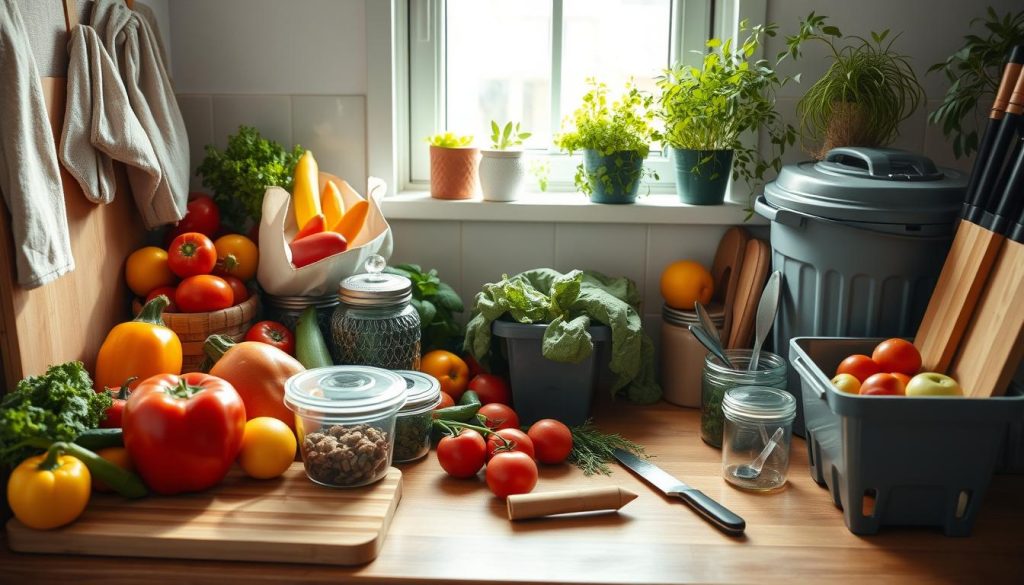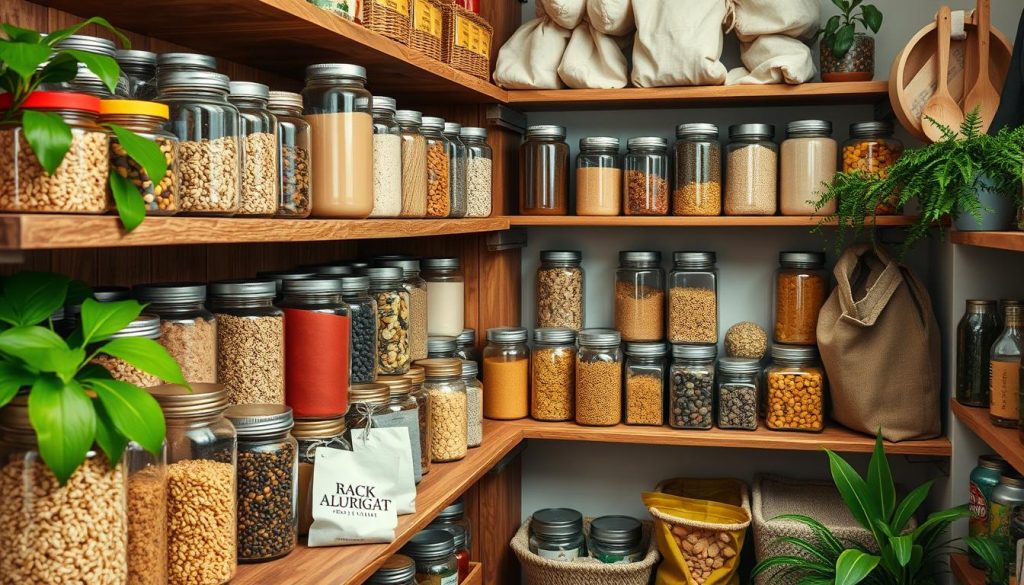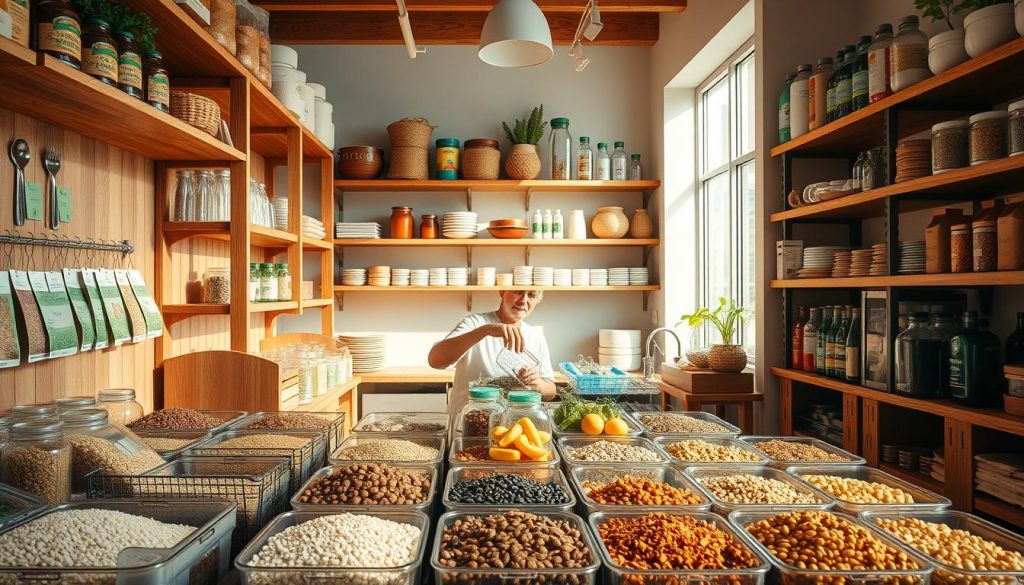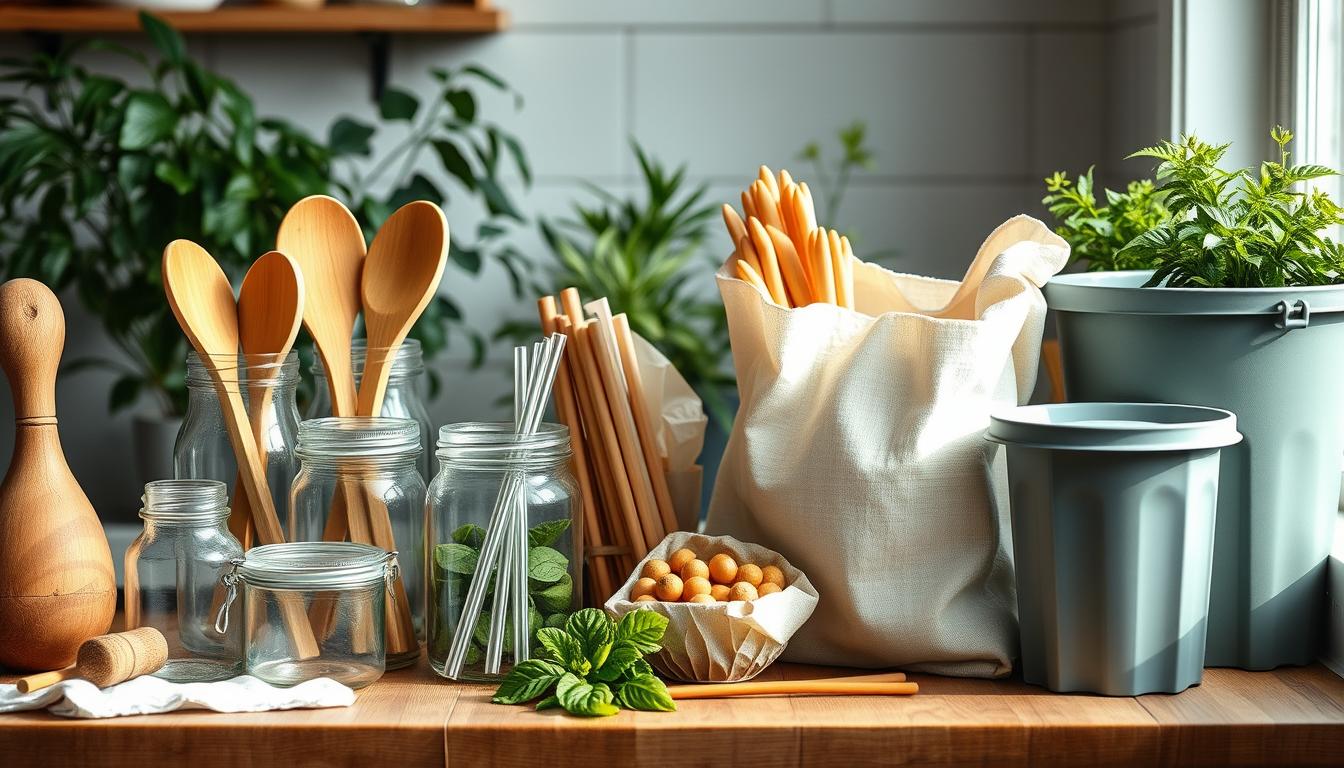I’m excited to share my journey towards a zero waste kitchen with you. It’s a path that’s changed how I cook and think about food. By adopting sustainable cooking practices, I’ve seen a big drop in my trash output and grocery bills.
Eco-friendly food prep isn’t just a trend – it’s a lifestyle that makes a real difference. From meal planning to smart shopping, every step counts. Let’s explore how to make your kitchen a hub of sustainability, reducing waste while enjoying delicious meals.
Ready to join me in creating a kitchen that’s kind to our planet? Let’s dive in and discover simple ways to make a big impact, one meal at a time.
Understanding the Zero Waste Kitchen Concept
I’m excited to explore the world of zero waste kitchens with you. This approach has changed my cooking habits and helped the environment. Let’s see what it means to have a zero waste kitchen and why it’s key.
What is a zero waste kitchen?
A zero waste kitchen tries to cut down on waste by reducing, reusing, and recycling. I’ve started shopping wisely, using all parts of my ingredients, and composting food scraps. It’s about making choices to reduce packaging and food waste in our kitchens.
Benefits of adopting a sustainable kitchen lifestyle
Adopting a zero waste kitchen has many benefits for me. I’ve saved money by buying in bulk and cutting down on food waste. My cooking has become more creative as I use every ingredient. Plus, I feel proud of helping the planet.
Environmental impact of traditional kitchen practices
Traditional kitchen habits can harm our planet. Single-use plastics, too much packaging, and food waste end up in landfills and pollute. Zero waste practices can greatly reduce our carbon footprint and save resources for the future.
| Traditional Kitchen | Zero Waste Kitchen |
|---|---|
| Single-use plastics | Reusable containers |
| Food waste to landfills | Composting |
| Excessive packaging | Bulk shopping |
Understanding these ideas helps us start our own zero waste kitchens. This way, we can help make the future more sustainable.
Assessing Your Current Kitchen Habits
Starting a zero waste kitchen might seem hard at first. That’s why I’m here to help you check your current ways. By looking closely at your habits, we can find ways to improve. This will help you reduce food waste and prep food in a greener way.
Let’s look at common waste sources in your kitchen. Single-use plastics are a big problem. Think about all the plastic bags, wraps, and containers you use every day. Also, think about food waste. Do you often throw away bad produce or leftovers?
To help you check your kitchen habits, I’ve made a simple checklist. Take a moment to go through these items and think about your current practices:
- Do you plan meals in advance to avoid overbuying?
- How often do you use reusable containers instead of disposable ones?
- Are you composting food scraps?
- Do you buy in bulk to reduce packaging waste?
- Have you explored alternatives to plastic wrap and bags?
Now, let’s look at some data to understand the impact of our kitchen habits:
| Kitchen Item | Average Annual Waste | Sustainable Alternative |
|---|---|---|
| Plastic Wrap | 745 sq ft | Beeswax wraps |
| Paper Towels | 80 rolls | Reusable cloth towels |
| Plastic Bags | 500 bags | Reusable produce bags |
| Food Waste | 219 lbs | Meal planning and composting |
By spotting these areas in your kitchen, you’re taking a big step towards a plastic-free pantry. Remember, small changes can make a big difference over time!
Eco-Friendly Food Prep Techniques

I’ve found that using eco-friendly food prep is crucial for a green kitchen. Smart methods help us cut down on waste and cook better for the planet.
Meal planning to reduce waste
Planning meals ahead saves money and reduces waste. I make a weekly menu and a shopping list. This has cut down my food waste a lot.
Using every part of your ingredients
Being creative with ingredients is a big win for sustainable cooking. I use veggie scraps for broth, citrus peels for zest, and stale bread for croutons. Nothing is wasted in my kitchen!
Proper food storage methods
Storing food right keeps it fresh longer and prevents waste. I use airtight containers, separate fruits and veggies, and keep my fridge tidy. These steps have helped a lot in reducing waste.
| Ingredient | Storage Method | Shelf Life |
|---|---|---|
| Leafy Greens | Wrapped in damp paper towel, in a sealed bag | 1-2 weeks |
| Berries | Unwashed, in a single layer in a breathable container | 5-7 days |
| Herbs | Stems in water, covered with a plastic bag | Up to 2 weeks |
By using these eco-friendly food prep methods, I’ve made my kitchen very sustainable. It’s incredible how small changes can make a big difference in reducing waste and making cooking more green.
Creating a Plastic-Free Pantry

Setting up a plastic-free pantry is a big step towards living sustainably. It’s not just about making your kitchen look good. It’s about cutting down on waste and choosing eco-friendly options. Let’s explore how to make your pantry plastic-free and live more sustainably.
The first thing to do is switch from plastic containers to reusable ones. Glass jars and stainless steel containers are great. They’re tough, easy to clean, and keep food fresh. Plus, they look great on your shelves!
Buying in bulk is essential for a plastic-free pantry. I use my own containers for items like rice, beans, and nuts. This way, I avoid extra packaging and save money.
Here’s a quick guide to help you start your plastic-free pantry journey:
- Replace plastic containers with glass jars or stainless steel options
- Use cloth bags for storing produce and bulk items
- Opt for bamboo or wooden utensils instead of plastic ones
- Choose package-free products when possible
- Label your containers clearly to stay organized
Changing to a plastic-free pantry takes time. Start small and replace items as you use them up. Soon, you’ll have a beautiful, sustainable pantry to be proud of!
| Plastic Item | Sustainable Alternative | Benefits |
|---|---|---|
| Plastic food containers | Glass jars | Durable, non-toxic, easy to clean |
| Plastic bags | Cloth produce bags | Reusable, washable, breathable |
| Plastic wrap | Beeswax wraps | Natural, compostable, versatile |
| Plastic utensils | Bamboo or metal utensils | Long-lasting, biodegradable (bamboo) |
Smart Shopping for a Zero Waste Kitchen

Starting a zero waste kitchen begins with smart shopping. I’ve noticed big changes by tweaking my grocery habits. Let’s dive into some eco-friendly shopping tips.
Bulk Grocery Shopping Tips
Bulk shopping is a big help for a zero waste kitchen. I always carry reusable containers for pantry staples. Here are some tips I’ve picked up:
- Find local stores with bulk sections
- Weigh your containers before filling
- Use cloth bags for loose produce
- Buy only what you need to avoid waste
Choosing Package-Free Products
Choosing products without packaging is key. I go for fresh fruits and veggies, picking loose items over packaged ones. For dairy and meats, I ask the deli to use my containers.
Bringing Your Own Reusable Containers and Bags
Reusable containers are vital for a zero waste kitchen. I always have containers, jars, and bags ready for shopping. This has greatly reduced single-use plastics in my kitchen.
| Item | Reusable Alternative |
|---|---|
| Plastic produce bags | Mesh or cloth produce bags |
| Plastic shopping bags | Sturdy canvas totes |
| Disposable food containers | Glass jars or stainless steel containers |
By using these smart shopping tips, I’ve made my kitchen more sustainable. It’s incredible how small changes can make a big difference in reducing waste.
Mastering Food Waste Reduction
Reducing food waste is key to sustainable cooking. It’s good for the planet and saves money. Let’s look at some ways to cut down on waste in your kitchen.
Controlling portions is essential. I measure ingredients carefully to avoid overcooking. Leftovers? They become soup, croutons, or smoothies.
Knowing when food goes bad is important. “Best by” doesn’t mean it’s bad after. I check food’s freshness with my senses. I plan meals around items near expiration.
- Store food properly to extend shelf life
- Freeze excess produce for future use
- Use airtight containers to keep food fresh longer
Composting is great for food waste. It turns kitchen scraps into soil. I started with a small bin and now have a big garden. It’s good for the planet and my plants!
These steps have cut down my kitchen waste a lot. It’s a learning journey, but it’s worth it. Every small step helps us move towards a zero-waste kitchen.
Composting and Recycling Kitchen Scraps
Composting and recycling kitchen scraps are key to a zero waste kitchen. These practices cut down on food waste and help my garden. Let’s look at how to set up a compost system and reduce food waste.
Setting up a Kitchen Compost System
Starting a kitchen compost system is simple. I use a small bin with a tight lid to collect scraps. This keeps odors in and pests out. When it’s full, I move it to my outdoor compost bin.
What Can and Can’t Be Composted
It’s important to know what can be composted. Here’s a quick guide:
| Compostable | Not Compostable |
|---|---|
| Fruit and vegetable scraps | Meat and dairy products |
| Coffee grounds and filters | Oily foods |
| Eggshells | Diseased plants |
| Tea bags (without staples) | Pet waste |
Creative Ways to Recycle Food Waste
There are many ways to recycle kitchen scraps. I make vegetable stock from veggie peels and ends. I also use coffee grounds as a natural fertilizer.
And I turn citrus peels into homemade cleaning solutions. These methods have greatly reduced my kitchen waste. They also provide valuable resources for my home and garden.
Embracing Reusable Containers and Utensils
Switching to reusable containers has changed my kitchen for the better. It’s cut down on waste and saved me money. I use glass jars, stainless steel boxes, and silicone bags for leftovers and lunches.
Having the right tools makes cooking greener. I’ve replaced single-use plastics with bamboo utensils, cloth napkins, and metal straws. These items are not only durable but also stylish.
Keeping things clean is crucial in a zero waste kitchen. I wash my containers with hot, soapy water and let them air dry. For tough stains, a baking soda paste works great. With care, these items can last for years, making eco-friendly living easy and rewarding.
